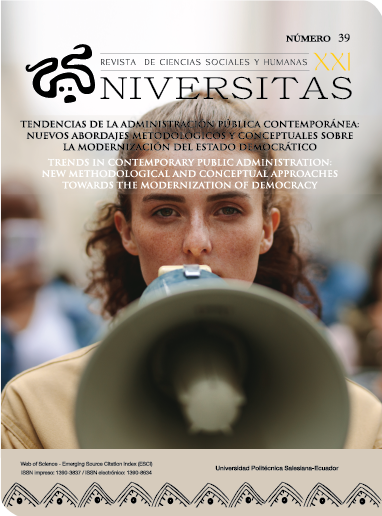Audience editors: between metrics and journalistic routines
Main Article Content
Abstract
Article Details
Universitas-XXI Journal aligns with the principles of open access and academic collaboration by adopting the Creative Commons Attribution-NonCommercial-ShareAlike 4.0 International License (CC BY-NC-SA 4.0). This license ensures that published content can be used and shared widely under the following conditions:
Attribution: Authors and the journal must be appropriately credited as the original creators of the content, with full reference and a link to the publication provided.
Non-commercial use: Content may not be used for commercial purposes, preserving its academic and educational intent.
ShareAlike: Derivative works must be distributed under the same terms as this license, promoting the creation of accessible and equitable knowledge.
By implementing this license, the Universitas-XXI Journal strengthens its commitment to disseminating high-quality research, providing free access to knowledge, and fostering a collaborative environment among researchers, educators, and students worldwide.
This decision reflects core values of responsibility, ethics, and transparency in academia, ensuring that intellectual contributions serve as a foundation for new research and projects while respecting the rights of authors and the scientific community.
For more information about this license, please visit the following link: https://creativecommons.org/licenses/by-nc-sa/4.0/"
References
Alujevic Vesnic, L. y M.F. Murru (2016). “Digital audiences disempowerment: Participation or free labor”. Journal of Audiences&Reception Studies, Vol 13, Issue 1, pp.422-430.
Anderson, C.W. (2011). “Deliberative, Agonistic, and Algorithmic Audiences: Journalism´s Vision of Its Public in an Age of Audience Transparency”, International Journal of Communication, 5:19
Becerra, M. (2019). “Nuevos medios, agenda vieja”, en Letra P: https://www.letrap.com.ar/nota/2019-12-15-10-43-0-nuevos-medios-agenda-vieja
Boczkowski & Mitchelstein (2013) The News Gap. When the Information Preferences of the Media and the Public Diverge. The Mit Press, Cambridge, Londres.
Calvo, E. y Aruguete, N. (2020). Fake news, trolls y otros encantos. Como funcionan (para bien y para mal) las redes sociales. Buenos Aires: siglo XXI.
Cherubini, Federica and Nielsen, Rasmus Kleis, Editorial Analytics (2016). How News Media are Developing and Using Audience Data and Metrics. Oxford: Reuters Institute
Diakopoulos Nicholas (2015) Algorithmic Accountability, Digital Journalism, 3:3, 398-415, DOI: 10.1080/21670811.2014.976411
Fischer, S., Jaidka, K. & Lelkes, Y. Auditing local news presence on Google News. Nature Human Behaviour 4, 1236–1244 (2020). https://doi.org/10.1038/s41562-020-00954-0
Haim, M., Andreas Graefe &Hans-Bernd Brosius (2017). “Burst of the Filter Bubble? Effects of personalization on the diversity of Google News”, Digital Journalism, pp. 330-343
Haim, Mario, Andreas Graefe & Hans-Bernd Brosius (2018) Burst of the Filter Bubble?, Digital Journalism, 6:3, 330 343, DOI: 10.1080/21670811.2017.1338145
Heikki, H. &Ahva, L. (2015). The Relevance of Journalism. Journalism Practice 9:1, 50-64. https://doi.org/10.1080/17512786.2014.928465
Hernández Perez, T. y David Rodríguez, M. (2016). Medición integral de las audiencias: sobre los cambios en el consumo de información y la necesidad de nuevas métricas en medios digitales”, En Hipertext.net, nro 14. DOI: 10.2436/20.8050.01.32
MacGregor, P. (2007). “Tracking the online audience. Metric data start a subtle revolution”. Journalism Studies, v.8, n 2, pp. 280-298. https://doi.org/10.1080/14616700601148879
Huyen Le, Raven Maragh, Brian Ekdale, Andrew High, Timothy Havens, and Zubair Shafiq. 2019. Measuring Political Personalization of Google News Search. In Proceedings of the 2019 World Wide Web Conference (WWW’19), May 13–17, 2019, San Francisco, CA, USA. ACM, New York, NY, USA, 7 pages. https://doi.org/10.1145/3308558.3312504.
MacGregor P. 2007 ‘Tracking the Online Audience, Metric data start a subtle revolution’ Journalism Studies : Vol 8 (2), p280-298. https://doi.org/10.1080/14616700601148879
Masip, Pere (2016). “Investigar el periodismo desde las perspectivas de las audiencias”. El profesional de la información, v.25, n.3, pp. 323-330. https://doi.org/10.3145/epi.2016.may.01
Mitchelstein & Boczkowski (2017) Juventud, estatus y conexiones. Explicación del consumo incidental de noticias en redes sociales, Revista Mexicana de Opinión Pública, núm. 24, pp. 131-145. DOI 10.22201/fcpys.24484911e.2018.24.61647
Retegui, L. (2014). Trabajo creativo, TIC y mecanismos de control en los procesos laborales en las industrias culturales. Un estudio de caso en Argentina. Global Media Journal México, Volumen 11, Número 22 Pp. 20-42.
Rodríguez-Vázquez, A., S. Direito-Rebollal y A. Rodríguez (2018). Audiencias crossmedia: nuevas métricas y perfiles profesionales en los medios españoles. El profesional de la información, 2018, julio-agosto, v. 27, n. 4., pp. 793-800. https://doi.org/10.3145/epi.2018.jul.08
Reese, Stephen & Shoemaker, Pamela. (2016). Media Sociology and the Hierarchy of Influences Model: A levels-of-analysis perspective on the networked public sphere. Mass Communication and Society. 19. Doi: 10.1080/15205436.2016.1174268.
Tandoc, E. C. (2014). Journalism is twerking? How web analytics is changing the process of gatekeeping. New Media & Society, 16(4), 559–575. https://doi.org/10.1177/1461444814530541
Van- Dalen, Arjen (2012). “The algorithms behind the headlines”. Journalism practice, v.6, n.5-6, pp. 648-658. https://doi.org/10.1080/17512786.2012.667268
Vu, Hong Tien (2014). The online audience as gatekeeper: The influence of reader metrics on news editorial selection. Journalism 2014, Vol. 15(8) 1094–1110. DOI: 10.1177/1464884913504259
Welbers, K., Van Atteveldt, W., Kleinnijenhuis, J., Ruigrok, N., & Schaper, J. (2016). News selection criteria in the digital age: Professional norms versus online audience metrics. Journalism, 17(8), 1037-1053. https://doi.org/10.1177/1464884915595474.
Zunino, E. y Grilli Fox, A. (2019) Medios digitales en la Argentina: posibilidades y límites en tensión. Estudios sobre el mensaje periodístico 26(1) pp. 401-413, https://doi.org/10.5209/esmp.67320

